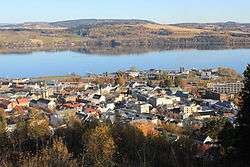Please tell us which country and city you'd like to see the weather in.

Gjøvik Line
The Gjøvik Line (Norwegian: Gjøvikbanen) is a Norwegian railway line between Oslo and Gjøvik. It was originally named the North Line (Nordbanen) and ran between Grefsen and Røykenvik. The line was completed to Gjøvik in 1902. The Gjøvik Line was one of the first lines of the Norwegian railway system which was to be contracted on public service obligation, but it was the state owned Norges Statsbaner which won it through its subsidiary NSB Anbud.
The line
The lines is the smallest and least trafficked railway line from Oslo, and the only single track line in the capital. Like most other Norwegian railway lines, the entire 124 km long line is electrified at 15 kV 16 2⁄3 Hz AC.
It serves some of the northern neighborhoods of Oslo, and has a few stations in the woods of Nordmarka. Further north the line serves the municipality of Nittedal. At Roa, the Roa–Hønefoss Line branches off to Hønefoss, where it continues as the Bergen Line. Formerly, most trains between Oslo and Bergen used this route, but nowadays most passenger trains run on the route through Drammen, which is slightly longer but which runs through more densely populated areas. Freight trains however often use the line over Roa. Further north, the Gjøvik Line runs through the district of Toten before ending at Gjøvik.

Gjøvik
![]() Gjøvik is a town and a municipality in Oppland county, Norway. The administrative centre of the municipality is the town of Gjøvik.
Gjøvik is a town and a municipality in Oppland county, Norway. The administrative centre of the municipality is the town of Gjøvik.
In 1861, the village of Gjøvik in the municipality of Vardal was granted town status and was separated from Vardal to form a separate municipality. On 1 January 1964, the neighboring rural municipalities of Biri, Snertingdal, and Vardal were all merged into the municipality of Gjøvik.
Etymology
The town is named after the old Gjøvik farm (Old Norse: Djúpvík), consisting of the elements djúpr "deep" and vík "inlet".
Coat of arms
The coat of arms were granted on 2 September 1960. The arms show a white swan (Cygnus cygnus).
The former coat of arms, adopted in 1922, was a linden tree, with the statement Vis et voluntas (meaning "Force and will") on the lower part of the shield. The following design was a so-called "potpourri" vase, the most significant design of the glassworks that was the funding industry of the town.
Geography
Along with Hamar, Lillehammer, Brumunddal and Moelv, Gjøvik is one of the many towns bordering Norway's biggest lake, Mjøsa. The town administration of Gjøvik also covers the suburb area Hunndalen and the rural districts of Biri, Snertingdal, and Vardal. The municipal population is 28,807 (2010). About 16,000 people live in the urban area proper.
Radio Stations - Gjøvik
SEARCH FOR RADIOS
Podcasts:

